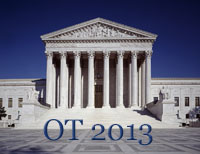US Supreme Court Review: Two Labor Law Cases (Noel Canning and Harris v. Quinn)
 (This is another post in our series, Looking Back at the U.S. Supreme Court’s 2013 Term.) Last month I commenced a series of posts of the United States Supreme Court’s labor and employment law decisions last term by blogging on the Court’s decision in the First Amendment public employee free speech case of Lane v. Franks, No. 13-483 (June 19, 2014). In two separate blog posts, I will comment on two labor law Court decisions (NLRB v. Noel Canning and Harris v. Quinn) and two employee benefit/ERISA decisions (Burwell v. Hobby Lobby Stores, Inc. and Fifth Third Bancorp v. Dudenhoeffer). This post discusses the labor law cases.
(This is another post in our series, Looking Back at the U.S. Supreme Court’s 2013 Term.) Last month I commenced a series of posts of the United States Supreme Court’s labor and employment law decisions last term by blogging on the Court’s decision in the First Amendment public employee free speech case of Lane v. Franks, No. 13-483 (June 19, 2014). In two separate blog posts, I will comment on two labor law Court decisions (NLRB v. Noel Canning and Harris v. Quinn) and two employee benefit/ERISA decisions (Burwell v. Hobby Lobby Stores, Inc. and Fifth Third Bancorp v. Dudenhoeffer). This post discusses the labor law cases.
To begin, National Labor Relations Board v. Noel Canning, 134 S. Ct. 2550 (June 26, 2014), is obviously much more than just an ordinary labor law case. Yes, it concerns the validity of decisions made by the National Labor Relations Board (NLRB or Board) when it had a quorum based solely on presidential recess appointments from roughly January 2012 through August 2013. More specifically, on January 4, 2012, President Obama, faced with the prospect of another two-member Board (see below why this is a problem), used his constitutional recess appointment powers to make three intra-recess appointments. In an effort to prevent any intra-session appointments, the Republican-controlled House of Representatives refused to give its consent to the Democratic-controlled Senate to go into recess. See U.S. Const. Art. II, sec. 5 (“[n]either House, during the session of Congress, shall, without the consent of the other, adjourn for more than three days . . . .”). In response, the Senate held very brief, pro forma sessions in which no business was conducted.
